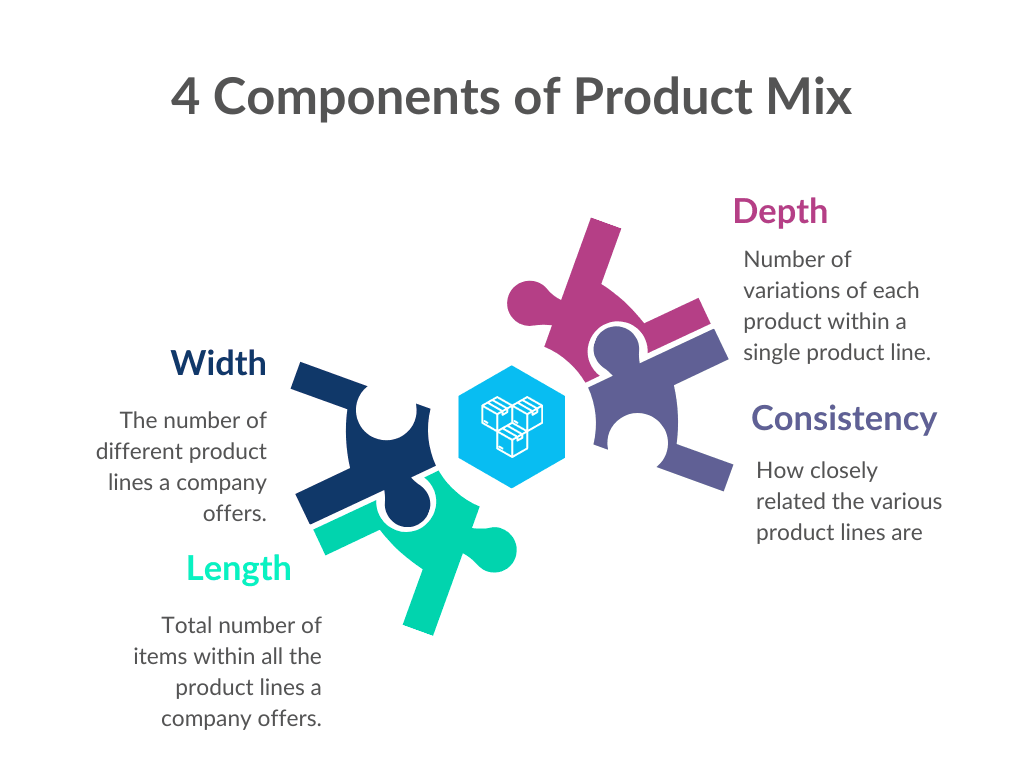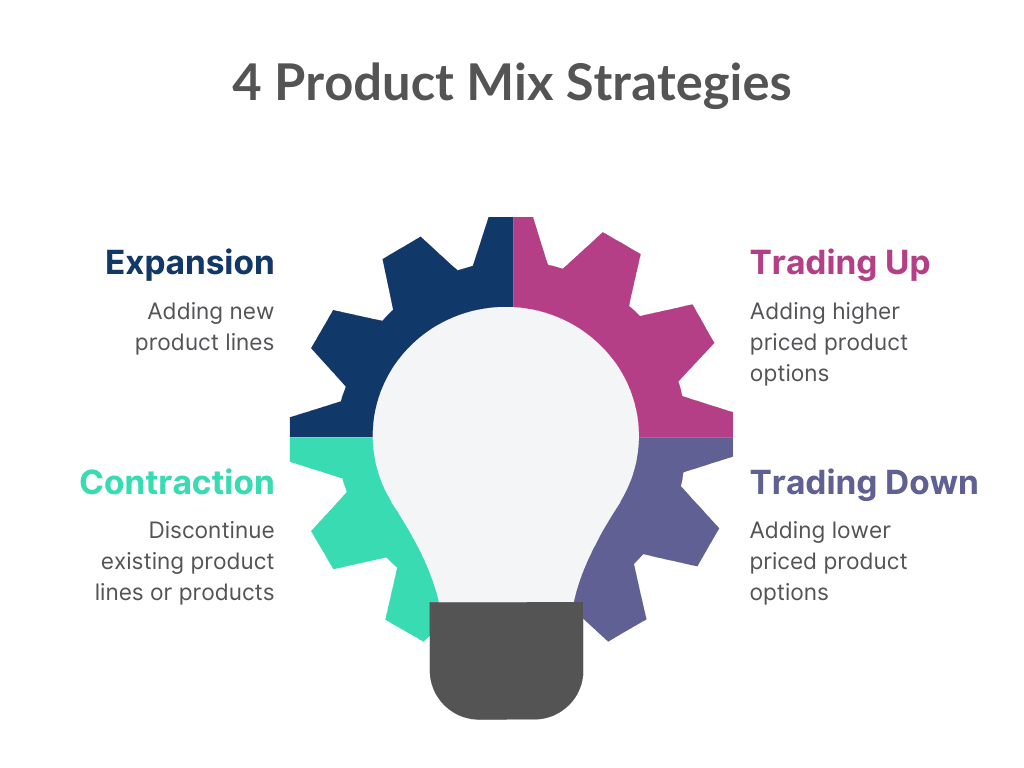Updated: August 16, 2024- 10 min read
The product management glossary is complex, to say the least. It's easy to get lost in a sea of concepts and overlapping definitions. Terms like product line, product portfolio, and product portfolio management are some of these concepts that need clarification.
Our primary goal today is to shed light on these fundamentals.
We’ll dive into the concept of product mix. We’ll break down its essential elements, explain why it’s strategically important, and explore how it can give your company a competitive edge.
Whether you're working with a single product line or managing an entire product portfolio, knowing how to optimize your product mix can be a game changer. It helps you decide how wide or narrow your offerings should be, how deep to go into each category, and how consistent your products are across the board.
Let’s get to the heart of what makes a product mix an indispensable tool of product management.
Free Value Proposition Canvas
Learn how to take user problems as the foundation of your solution and only build products that matter with our free Value Proposition Canvas!
Get Yours Now
What Is Product Mix?
A product mix, sometimes referred to as a product assortment, is the complete range of products (product lines and individual products) that a company offers to its customers. In essence, it is the entire range of products that a company makes available in the market.
The product mix shows how wide and deep a company’s offerings are. Knowing how to manage the product mix affects how the company is seen in the market, how well it meets customer needs, and how it stands up against competitors.
Understanding the product mix helps a company make educated decisions about what products to develop, how to market them, and how to use resources effectively. A product mix can help a company reach different customer groups, adapt to market changes, and increase profits, all while maintaining a strong and consistent brand.
What Are the 4 Components of Product Mix?

There are four key product mix dimensions. Understanding and optimizing each dimension is essential for companies to make sense of their product mix.
1. Width of Product Mix
This refers to the number of different product lines a company offers. For instance, if a company is building both CRM solutions and back-office admin software, the width of its product mix includes these two lines.
A broader width can help tap into different market segments. However, it also requires careful management to maintain quality and brand consistency across diverse offerings.
2. Length of Product Mix
Length is the total number of items within all the product lines a company offers. If each product line includes various models or variations, the length measures how many distinct products exist across all lines.
For example, consider a company that sells home appliances like refrigerators, washing machines, and ovens. If they offer five different refrigerator models, four washing machine models, and three oven models, the length of their product mix would be 12.
Companies with extensive product lines might have a long product mix length, which can cater to more specific customer needs but also demands greater resources for production, marketing, and support.
3. Depth of Product Mix
This dimension measures the number of variations of each product within a single product line. Variations could include different sizes, colors, features, or flavors.
For instance, within a product line of smartphones, depth could be reflected in different models, storage capacities, or screen sizes. A deeper product mix allows for more tailored offerings to meet niche demands but can complicate inventory management and forecasting.
4. Consistency of Product Mix
Consistency refers to how closely related the various product lines are in terms of their end-use, production processes, distribution channels, or any other relevant factors.
High consistency means that the products share similar attributes or purposes. Having a consistent product mix can streamline operations and branding. On the other hand, low consistency may indicate a more diversified approach, reducing risk but also requiring more varied expertise and resources. Mostly big brands can afford to take this approach.
A company that produces only personal care items like shampoo, conditioner, and body wash has a high level of consistency. All products are related in terms of end-use, production processes, and distribution channels
On the other hand, a company that sells both home appliances and personal care products—like refrigerators, washing machines, and shampoos—has a lower level of consistency. These products serve very different purposes, require different production methods, and often reach the market through separate channels, making them harder to manage together.
What Is a Product Mix Strategy?
A product mix strategy is the approach a company takes to manage and optimize its entire range of products. The goal of a product mix strategy is to create a balanced portfolio that meets market demands, aligns with the company’s brand, and drives profitability.
For example, a company might choose to expand its product mix by adding new product lines to reach a broader market. In contrast, it might deepen its existing lines after running a product analysis by offering more variations of a popular product. How a company decides to go about organizing its product mix can be boxed within one of the four following strategies:

4 Product Mix Strategies
Expansion: A software company that currently offers only product management tools could expand by adding a new product line, like time-tracking software. Product expansions allow the company to serve a broader range of customer needs within the same market.
Contraction: A digital platform that offers multiple niche apps, such as a photo editing app and a document scanner, might decide to discontinue the scanner app due to low usage. By contracting its product mix, the company can focus more resources on improving and marketing the photo editing app.
Trading Up: A video streaming service might introduce a premium subscription tier with higher video quality, exclusive content, and additional features. This strategy aims to attract customers who are willing to pay more for an enhanced viewing experience.
Trading Down: A cloud storage provider might offer a new, lower-cost plan with reduced storage space and fewer features. This would appeal to users who need basic storage solutions and are more price-sensitive, broadening the company's market reach.
The Difference Between Product Mix and Product Line
A product line is a group of related products that a company offers. They are similar in some way, like serving the same purpose, having similar features, or being made for the same type of customer. For example, if a company makes different kinds of laptops—like a basic model, a gaming model, and a high-performance model — those laptops together make up a product line.
Product mix, on the other hand, is the total collection of all the product lines that a company offers. It includes every product the company makes or sells. So, if that same company also makes smartphones, tablets, and software, all of these product lines together form the company’s product mix.
In short, a product line is one specific group of related products, while a product mix is the full range of everything a company offers. Therefore, a product mix consists of different product lines as well as a multitude of different products regardless of their level of consistency.
Product Mix Example: Google
Google, one of the world’s leading tech giants, has a diverse product mix that spans several industries and user needs. As you know, their product lines include search engines, advertising platforms, cloud services, hardware, and more.
Below is a breakdown of Google’s product mix, detailing each of the four components: width, length, depth, and consistency.
1. Google’s Product Line
Google’s product lines are diverse. They cover different sectors of the tech industry. Some of their major product lines include:
Search and Information Services: This includes Google Search, Google News, and Google Maps.
Advertising Platforms: Google Ads and Google AdSense, for example.
Cloud Services: Including Google Cloud Platform (GCP) and Google Workspace.
Hardware: Like Google Pixel phones, Google Nest smart home devices, and Chromecast.
Media and Entertainment: This includes YouTube, Google Play, and Google Stadia (prior to its closure).
Each of these product lines serves different customer needs and market segments.
2. Google’s Product Mix Components
Width: Google’s product mix width is broad. It covers multiple product lines across various sectors, from search engines to cloud computing, hardware, and digital media.
Length: The length of Google’s product mix is extensive, as each product line includes numerous distinct products. For example, the Google Pixel product line includes various models of smartphones, each with different specifications.
Depth: Google’s product mix depth is notable within each product line. For example, within the Google Workspace product line, there are various products such as Gmail, Google Docs, Google Drive, and Google Meet, each with different tiers and features catering to both individual users and enterprises.
Consistency: Google’s product mix shows a relatively high level of consistency, especially within the tech and digital services space. Many of their products are interconnected and complement each other, such as Google Search integrating with Google Ads, or Google Drive being seamlessly linked with Google Docs and Sheets. This consistency allows Google to create a cohesive ecosystem that enhances user experience and brand loyalty.
3. Google's Product Mix Strategy
Google mostly employs a combination of expansion and trading up strategies in its product mix.
Expansion Strategy: Over the years, Google has consistently expanded its product mix by adding new product lines and services. For instance, Google entered the hardware market with products like Pixel phones and Nest smart home devices, in addition to its core software and cloud services. This strategy has allowed Google to reach new customer segments and diversify its revenue streams.
Trading-Up Strategy: Google also uses a trading-up strategy by offering premium versions of its products. For example, Google Cloud Platform (GCP) provides enterprise-level services with advanced features compared to standard cloud offerings. Similarly, within Google Workspace, there are premium plans with additional storage, security, and collaboration tools tailored for larger businesses.
By combining these strategies, Google has built a robust product mix. It doesn’t only meet the needs of a wide range of users but also positions the company for long-term growth and recognizable product experience.
Their approach to product mix allows them to maintain a strong presence in the market. For decades they have adapted to changing consumer demands and continue to lead in the tech industry.
Product Mix vs. Marketing Mix
The terms product mix and marketing mix refer to different ideas, but they are sometimes confused. Let’s set things straight.
As we've established, product mix is the total range of products a company offers, including all product lines and individual items. At its core, it's about the variety, breadth, and depth of products available to meet customer needs.
On the other hand, marketing mix, often called the 4 Ps (Product, Price, Place, Promotion), is a broader concept that outlines the strategic components a company uses to market its offerings.
So, there you have it. Product mix is a concept focusing on the actual products, whereas marketing mix encompasses all the strategies used to promote and sell those products.
Make Sense of Your Product Mix
Understanding and optimizing your product mix is crucial if you want to stay competitive. Whether you’re looking to expand, contract, trade up, or trade down, the right strategy can make all the difference.
Take a close look at your current product mix and identify areas for improvement. Consider how these strategies can help you better meet customer needs and achieve long-term success. Now is the time to make your product mix work harder for your business.
Product Comparison Template
Winning products get to the core of a user need—and then solve it better than the competition. Use this template to identify your user need and evaluate other players in the market.
Get template
Updated: August 16, 2024




